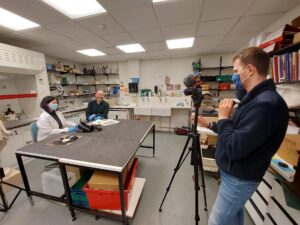Auld Reekie Retold; New Stories of an Old City at Museums & Galleries Edinburgh
In this case study Nico Tyack, Collections Information Officer at Museums & Galleries Edinburgh talks about managing the Auld Reekie Retold collections inventory project and integrating public engagement into it.

The project
At its heart, Auld Reekie Retold was a collections inventory project to establish the exact scope and nature of the collections held in store by Museums & Galleries Edinburgh. It ran from September 2019 to September 2022, and culminated with an exhibition held at the City Art Centre.
The project aimed to improve the information held by the service about the collections, repack it using modern materials and techniques, and set up a procedure for recording stories about objects received either through curatorial research, or from external sources with lived experience.
Public engagement was a key part of the project methodology. Not only was this an effective way to identify new perspectives and stories about items, it was also an opportunity to bring the work of collections management to the forefront, and run a programme of events looking at curatorial practice, documentation and conservation, and the extensive detective work undertaken to give museum collections meaning.
Five months into the project, a series of national lockdowns and public health restrictions were imposed which were only beginning to lift in the last six months or so of the project. The project team had to deliver both the collections management and engagement targets in the most challenging working environment many of us have seen.
The Auld Reekie Retold project was a fantastic opportunity to review many of our collections but its greatest impact is the way it set up a collections workflow from acquisition, to digitisation, cataloguing and repacking. Along the way, it allowed engagement with existing and new audiences about what a museum collection should be and who it belongs to.
Nico Tyack, Collections Information Officer, Museums & Galleries Edinburgh
Challenges and successes
- At the early stages, the main challenge was creating a project team and workflow with limited resources. We secured council funding for three full time Collections Projects Assistants who began at the start of the project. A year in, a successful application to MGS’ Museums Development Fund allowed us to recruit a Collections Engagement Officer to lead on the public programme.
- Existing curators were moved onto the project, with the agreement that an embargo on loans, enquiries and donations would be in place. The challenge was not being able to do a trial run of the project workflow before the project starting properly. It took a while to settle into a rhythm with clearly defined roles, but this was achieved by a flexible attitude, and trying out different ways of working.
- The COVID pandemic began just as we were starting to recruit a Collections Engagement Officer. We went ahead, expecting the restrictions not to last too long. In reality, all but 4 events of the project took place online. Communication of the project highlights, and publicising project events was most effective on Twitter and Facebook, with a new series of short “Talking Objects” films made for Instagram. The project gained momentum, with the initial series of online talks better attended than our in-person capacity.
- We quickly understood that people like seeing and learning about objects, but also about the work done for the safety and care of objects. We also learnt that, particularly during the lockdowns, people liked our informal, approachable communication style.
- Thankfully, throughout the project we were able to access our EMu CMS remotely from home. Using Teams, we set up workflow and requests so project team members could ask for photography of specific items by those on site. Once uploaded to EMu then detailed cataloguing and researching could be done from home.
The impact it has made
- The events programme had a positive impact on attendees, with reminiscence, rekindling old friendships, and adding to their own family history as the main outcomes. For us, the sessions addressed specific issues about items in the collections which the curators had been unable to establish.
- The workflow we adopted during the project, particularly for making requests for photography and specific collections tasks, is still in place, and is being developed. Curators still work from home for a proportion of the week, and so being able to upload images to EMu has greatly sped up the cataloguing process.
- New photography and filming skills harnessed during the project, and the equipment bought through MGS funding continues to be used to create fillms in-house for use online and in exhibitions (as used in the Auld Reekie Retold exhibition), for object documentation and for images made available for commercial use.
- The Story Catching element of the project was nominated for the Collections Trust Award for 2022 and came Highly Commended.
Guidance
- If you’re thinking of a collections review or inventory, think how you can make it participatory and engaging.
- Don’t be afraid to try out different ways of doing things; you won’t come up with the best workflow straight away, particularly if you don’t have specialists departments for each stage.
- Don’t underestimate how much museum audiences like to hear about what goes on behind the scenes. Include store tours and events as part of your review.
- Good photography equipment is not necessarily expensive. Invest in some kit and it will give you some great online content. It will also outlive your project.
Useful resources
The project was partly funded by MGS’s Museum Development Fund. Find out about MGS’s funding structure, grants outcomes and the projects and organisations MGS awards grants to.